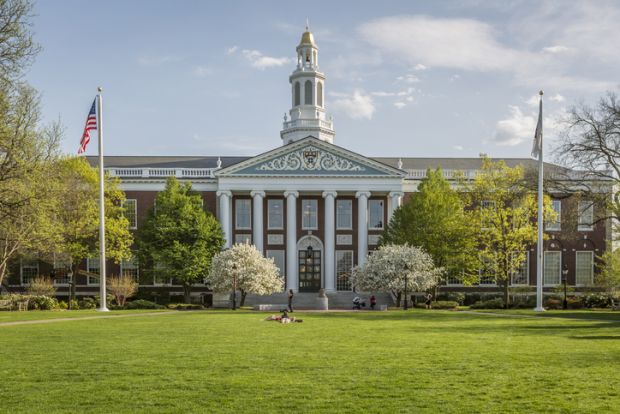
Everything is bigger in the US: the buildings, the drinks, the endowments. The most bountiful among the last has traditionally been that of Harvard University, which stood at $53.2 billion (£45.1 billion) as of June 2021. But a war-induced energy squeeze that has sent oil prices soaring to $120 a barrel is predicted to propel the University of Texas to the top of the pile, Bloomberg reports. The university’s $42.9 billion endowment is expected to swell thanks to the land it leases to oil firms. A fairly unpromising gift from the state in the 1800s, the university’s 2.1 million arid acres became a golden goose with the discovery of oil in May 1923. Environmental opposition from students and staff may make the windfall less appealing in years to come, but Texas’ land is also home to solar and wind power projects. Some folks get all the luck.
Holding exams online has led to a surge in cheating, taking an ancient arms race between invigilators and dishonest examinees into a creative new theatre. No one likes someone looking over their shoulder, but privacy campaigners say online proctoring is doubly invasive because it can involve someone peering into your own home to check for irregularities. Activists therefore celebrated a major win when a US federal judge ruled that scanning a candidate’s room before a test violated the US constitution, NPR reports. Aaron Ogletree, a chemistry student, successfully sued Cleveland State University in Ohio for breaching his fourth amendment rights, which protect US citizens against “unreasonable searches and seizures”. Judge J. Philip Calabrese concluded that Mr Ogletree’s privacy interest in his home outweighed Cleveland State’s interests in scanning his room. The university had argued that the 10-second scan was not a search and that Mr Ogletree could choose where to take his laptop and point its camera. Perhaps the real test was finding a dorm-room view that wouldn’t scandalise officious eyes.
Branding can be a fickle business. Universities that built their reputations on nurturing faculty and excelling in research might have assumed that such yardsticks of quality would withstand the winds of fashion. Not so, says the former Ucas head Mary Curnock Cook, who has declared that the Russell Group of research-intensive UK universities is a “hollow brand”, with only a handful of members worth students’ time and money. “The Russell Group includes perhaps four or five genuinely outstanding universities, including, of course, Oxford and Cambridge. But amongst the rest there are some very modest performers,” she wrote in a Higher Education Policy Institute blog, gleefully seized on by The Times. Being big and doing lots of research are worthless hallmarks of quality for students, she wrote, who care more about teaching and their own progress. Pulling no punches, she said the Russell Group “has become a hugely successful if hollow ‘brand’ which is sadly distorting the market, student choice and political thinking”. Time for a rebrand?
Given such criticism – and the small matter of a cost-of-living crisis – UK university bosses could have picked a better time to launch their annual drive for higher tuition fees. Much talk after this year’s admissions round has focused on the risk of domestic students being pushed out of university places by their international counterparts, ignoring the tiny detail that many courses would not be viable without the money coming in from abroad. This autumn, a record one-fifth of undergraduates at leading institutions hail from overseas, a 7 per cent rise on last year, The Times reported. But sector leaders struck a less-than-apologetic chord, saying the decade-long freeze in UK student fees had tied their hands. Sir David Bell, vice-chancellor of the University of Sunderland, said: “You cannot expect to run universities on a fee level of £9,250 a year, which by 2025 will be worth around £6,000 in real terms because of inflation.” Meanwhile, Colin Riordan, vice-chancellor of Cardiff University, said Westminster had a “national duty to ensure that it was at least viable for us to teach students from this country”. With a new education secretary likely to be appointed in days, you can expect this row to really begin to heat up as summer fades.
“Has the bloom fallen off the rose of law professor life?” was the rather poetic way Reuters began its report into the declining number of applicants for what is often seen as a pretty plum post. In the US, competition for tenure track law professor positions has nosedived, falling 59 per cent from 2010, according to recent figures. This August, a mere 272 applicants had submitted their documents to the Association of American Law Schools’ Faculty Appointments Register (FAR) for new faculty candidates, down from more than 1,000 in its heyday. What’s going on? Some speculate that far from becoming a less lucrative career path, schools’ tough selection criteria are putting off a large number of potential applicants. For example, 43 per cent of last year’s intake had a law degree, compared with between 15 per cent and 27 per cent from 2012 to 2016, while many also had a PhD. With applications at a 10-year low, the chance of landing a job teaching law has, in theory, risen. But for those with law professor aspirations, the removal of hundreds of no-hopers is unlikely to make too much of a difference. Instead, it now appears that they are going to have to fight it out against the crème de la crème.
Register to continue
Why register?
- Registration is free and only takes a moment
- Once registered, you can read 3 articles a month
- Sign up for our newsletter
Subscribe
Or subscribe for unlimited access to:
- Unlimited access to news, views, insights & reviews
- Digital editions
- Digital access to THE’s university and college rankings analysis
Already registered or a current subscriber? Login



